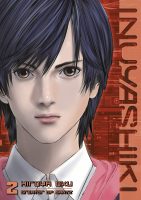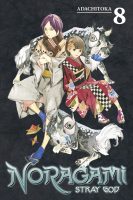My News and Reviews
Okay! A couple of different although expected things were posted last week at Experiments in Manga in addition to the usual My Week in Manga feature. First up was the announcement of the Complex Age Giveaway Winner which also includes a list of manga which incorporates cosplay in one way or another. I also posted the Bookshelf Overload for June last week for those of you interested in what manga and such I’ve recently acquired.
Other interesting things found online: As Anime Expo wrapped up early last week, a few more licensing announcements were made. Viz Media announced that it plans on publishing the fourth part of Hirohiko Araki’s JoJo’s Bizarre Adventure as well as Araki’s How to Create Manga. Yen Press will release Erased by Kei Sanbe and Bungo Stray Dogs written by Kafka Asagiri and illustrated Sango Harukawa. Also announced last week was SuBLime’s partnership with Libre, outlining their plans to release Ayano Yamane’s Finder series as well as other titles in English. Ani-gamers posted an interview with Rei Hiroe from AnimeNext 2016. And over at the Lobster Dance, the sixth installment of “The Sparkling World of 1970s Shojo Manga” takes a look at the Rose of Versailles franchise.
Quick Takes
 As Many As There Are Stars by Miecohouse Matsumoto. As Many As There Are Stars starts as one thing but by the end of volume the manga has turned into something else entirely. Matsumoto may very well have had this planned out in advance—hints about Kousuke’s tragic past and proclivities are present from very early on—but the shift in tone is still a bit jarring. As Many As There Are Stars is a boys’ love one-shot about seven young men who are all in the same club at college. Supposedly it’s an astronomy club of some sort, but it might as well be a club for sexual tension as most of the members have feelings for one or more of the others. The notable exception is the first year who, despite being an important plot point in the first chapter, is largely forgotten for the rest of the volume. Initially, the manga is fairly sweet and lighthearted if somewhat cliché as it explores the relationships between the club members. Eventually As Many As There Are Stars turns its focus onto Kousuke, an art student who is both desperate to be and terrified of being loved. What starts as a somewhat goofy manga develops into something more melancholic, a story about an unfortunate young man confronted by friendship and love.
As Many As There Are Stars by Miecohouse Matsumoto. As Many As There Are Stars starts as one thing but by the end of volume the manga has turned into something else entirely. Matsumoto may very well have had this planned out in advance—hints about Kousuke’s tragic past and proclivities are present from very early on—but the shift in tone is still a bit jarring. As Many As There Are Stars is a boys’ love one-shot about seven young men who are all in the same club at college. Supposedly it’s an astronomy club of some sort, but it might as well be a club for sexual tension as most of the members have feelings for one or more of the others. The notable exception is the first year who, despite being an important plot point in the first chapter, is largely forgotten for the rest of the volume. Initially, the manga is fairly sweet and lighthearted if somewhat cliché as it explores the relationships between the club members. Eventually As Many As There Are Stars turns its focus onto Kousuke, an art student who is both desperate to be and terrified of being loved. What starts as a somewhat goofy manga develops into something more melancholic, a story about an unfortunate young man confronted by friendship and love.
 Inuyashiki, Volumes 2-3 by Hiroya Oku. After reading the first volume of Inuyashiki, I was curious to see what direction Oku would take the series. At this point, I’m not entirely convinced that Oku actually has a cohesive overarching narrative in mind. Instead, the basic premise of the series creates a platform for Oku to tell some legitimately disturbing stories; I’m just not sure that there’s much of a point to them beyond their violence and depravity. Inuyashiki often feels like it’s being distasteful just to be distasteful in order to see just how far Oku can push the boundaries of acceptability. However, I will admit that it can be can oddly satisfying to see someone who looks like an elderly man protect others by beating the crap out of obvious wrongdoers. (Oku seems to go out of the way to make the bad guys as over-the-top and awful as possible, which is fitting for the series as a whole.) Inuyashiki—the previously mentioned old man—is starkly contrasted by Shishigami, the manga’s other, much younger, lead. Like Inuyashiki, Shishigami has been reborn as a cyborg. Unlike Inuyashiki, he has been using his newly-gained powers to cause death a mayhem at will. He is unyielding in his deliberate cruelty and absolutely terrifying.
Inuyashiki, Volumes 2-3 by Hiroya Oku. After reading the first volume of Inuyashiki, I was curious to see what direction Oku would take the series. At this point, I’m not entirely convinced that Oku actually has a cohesive overarching narrative in mind. Instead, the basic premise of the series creates a platform for Oku to tell some legitimately disturbing stories; I’m just not sure that there’s much of a point to them beyond their violence and depravity. Inuyashiki often feels like it’s being distasteful just to be distasteful in order to see just how far Oku can push the boundaries of acceptability. However, I will admit that it can be can oddly satisfying to see someone who looks like an elderly man protect others by beating the crap out of obvious wrongdoers. (Oku seems to go out of the way to make the bad guys as over-the-top and awful as possible, which is fitting for the series as a whole.) Inuyashiki—the previously mentioned old man—is starkly contrasted by Shishigami, the manga’s other, much younger, lead. Like Inuyashiki, Shishigami has been reborn as a cyborg. Unlike Inuyashiki, he has been using his newly-gained powers to cause death a mayhem at will. He is unyielding in his deliberate cruelty and absolutely terrifying.
 Noragami: Stray God, Volumes 8-14 by Adachitoka. I have been enjoying Noragami more and more as the series progresses, but I still managed to fall behind on the manga. I was actually intending to only read a few volumes this past week, but once I started I found myself devouring my entire backlog; Noragami continues to get better and better. More of Yato’s backstory has been revealed at this point and his past has become central to the plot. The narrative flow can be somewhat odd, though. In between the intensely dramatic and serious story arcs, Adachitoka has the tendency to introduce several chapters (or more) of what feels like playful filler material. However, I’m really enjoying Adachitoka’s modernized take on Japanese deities and mythologies. (I also appreciate the thorough translation and cultural notes included in the volumes.) The interplay between the gods, shinki, ayakashi, and humans is fascinating and the relationships and power dynamics between them all are marvelously complex and nuanced even if the characters’ actions aren’t always the most subtle. Adachitoka also isn’t afraid of killing off major characters, which heightens the tension of the series’ conflicts and it’s unlikely anyone will remain unscathed.
Noragami: Stray God, Volumes 8-14 by Adachitoka. I have been enjoying Noragami more and more as the series progresses, but I still managed to fall behind on the manga. I was actually intending to only read a few volumes this past week, but once I started I found myself devouring my entire backlog; Noragami continues to get better and better. More of Yato’s backstory has been revealed at this point and his past has become central to the plot. The narrative flow can be somewhat odd, though. In between the intensely dramatic and serious story arcs, Adachitoka has the tendency to introduce several chapters (or more) of what feels like playful filler material. However, I’m really enjoying Adachitoka’s modernized take on Japanese deities and mythologies. (I also appreciate the thorough translation and cultural notes included in the volumes.) The interplay between the gods, shinki, ayakashi, and humans is fascinating and the relationships and power dynamics between them all are marvelously complex and nuanced even if the characters’ actions aren’t always the most subtle. Adachitoka also isn’t afraid of killing off major characters, which heightens the tension of the series’ conflicts and it’s unlikely anyone will remain unscathed.
